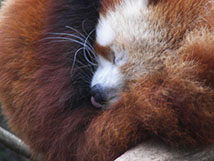The Red Panda
 By redpandasrule (sleepy) [CC-BY-SA-2.0, via Wikimedia Commons]
By redpandasrule (sleepy) [CC-BY-SA-2.0, via Wikimedia Commons]
Description
Raccoonlike in appearance, with a red coat, long tail and white spots on the cheeks, mouth and ears, the red panda is actually unrelated to its fellow tree dwellers. DNA testing has resulted in the species being placed in its own unique family.
Species
The red panda has been previously classified in the families Procyonidae (raccoons) and Ursidae (bears), but recent research has placed it in its own family Ailuridae, in superfamily Musteloidea along with Mustelidae and Procyonidae. Two subspecies are recognized:
Ailurus fulgens fulgens: Found in Nepal, northeastern India (West Bengal, Sikkim, Arunachal Pradesh), Bhutan, and part of China.
Ailurus fulgens styani (also known as a. f. refulgens): Only found in China (in the Hengduan Mountains in Sichuan and the East Nujiang River of Yunnan Province) and northern Myanmar.
Diet
The red panda’s diet is very unusual for a mammal and consists mostly of bamboo. When the weather is warm enough, they also eat insects and fruit. Although the giant panda eats almost every part of the bamboo plant (except the roots), the red panda only eats the youngest, most tender shoots and leaves.
To cope with the lack of food during the winter months, red pandas have evolved several ways of meeting their energy demands. For instance, red pandas can spend as much as 13 hours a day looking for and eating bamboo. They also have a very low metabolic rate (almost as low as sloths), and can slow their metabolism even further in colder temperatures. Finally, their thick fur covers their entire body, including the soles of their feet, allowing them to conserve their body heat.

